How You Can Easily Delay Climate Change Today: SO2 Injection
I used to feel powerless about climate change.
It’s accelerating.
We might be facing tipping points that are irreversible.
This might entail catastrophic crop failures, economic crashes, mass migrations, and conflict for resources.
Most of what we’re doing about it is too little, too late.
But there’s one thing we can do. Right now.
This article is about that thing.
And how we can personally have an impact today.
Global Warming Running Amok
It’s getting hot in here:
2023 was especially bad:
And 2024 is looking worse: This January was the hottest in Europe’s recorded history.
Unfortunately, the heating appears to be worse closer to the poles. Here’s the North Atlantic:
And here’s the Antarctic:
Which means we’re losing ice faster and faster.
The result:
Scientists are concerned: A new paper suggests Northern Europe will cool down and the Eastern US will warm up really fast in the next few decades, because sea current might grind to a halt:
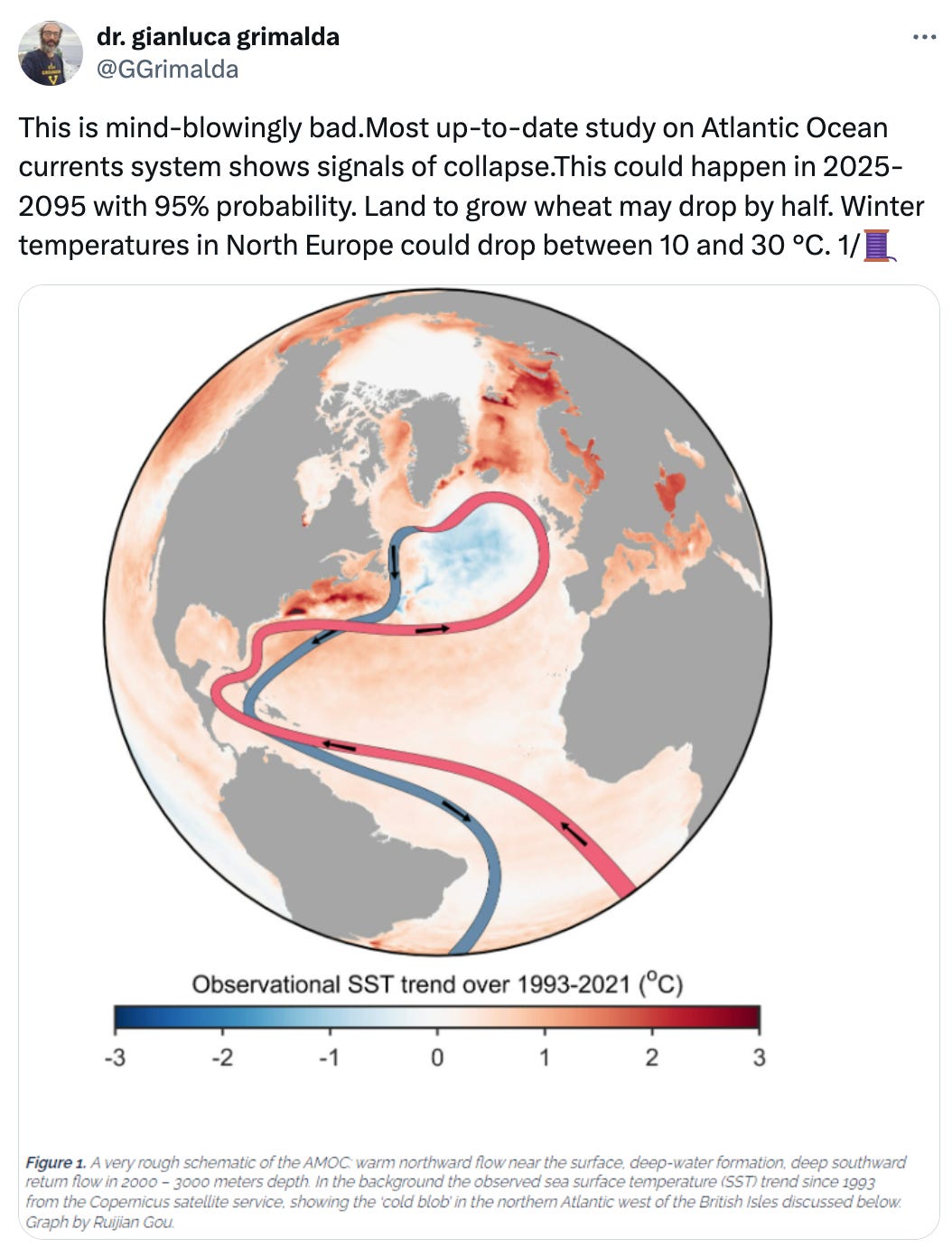
This transition could happen in a matter of months and be impossible to turn around in our lifetimes.
And we’re not slowing down our CO2 emissions. We’re increasing them:
Because these emissions are due to the biggest decrease in poverty the world has ever seen:
You won’t convince the masses of poor people around the world to stay poor. So CO2 concentrations are going to keep increasing and the CO2 in the atmosphere will reach ever greater heights.

I’m not a climate alarmist as you can see here and here. Humans won’t go extinct, nor will most species, and the Earth will be OK. But there will be consequences: Dramatic changes in weather patterns might mean more migration to escape it and the consequent international conflict. And that’s without considering agricultural failures when plants can’t adapt fast enough to weather changes. Which means less food, more migration, and an even worse cycle of violence.
I haven’t yet independently verified these fears, but they sound reasonable. So do we want to find out what happens if we continue to microwave the Earth?
In We Can Already Stop Climate Change If We Want To, I explained that we have a path to solve climate change (renewables, nuclear, batteries, olivine weathering), but it will take at least a few decades to get there. In the meantime, CO2 emissions will keep growing, there’s nothing we can do to reverse them fast enough, and global temperatures will keep increasing.
There is only one thing we can do to avoid these potentially catastrophic consequences: Cooling the Earth artificially until we get CO2 levels in hand. And the best way we know to do that is sending SO2 to the stratosphere.
I outlined that solution in the article linked above, but I didn’t go in depth, and many of you had questions:
Does it really work? How?
Is this really the best solution? What are the alternatives?
How safe is it? What are the downsides?
Will states allow this? Is it legal?
How much will it cost?
Where should we release this SO2?
So I dove into this, talked with the only company that I know that is trying to do this at scale, and as a result of this deep dive, I am trying to invest in the company1. Here’s what I found:
How Does SO2 Injection Work?
We need to inject particles into the stratosphere that reflect 1-2% of sunshine.
How Much SO2 Do We Really Need?
Here are the drivers of climate change today:
Notice something? There are two gases that increase global temperatures substantially (carbon dioxide and methane) and one that lowers them: sulfur dioxide. The entire idea is to make the big blue column here bigger and put it in the right place (stratosphere) so that it fully offsets the contributions of CO2.2
We’ve been inadvertently cooling off the Earth up to 0.5ºC without realizing it! Without SO2, the Earth would already be at 2ºC above pre-industrial levels!
The rule of thumb is that the relationship between SO2 and CO2 is one to one million:3 One gram of SO2 offsets one ton of CO2 for one year!
We have added about 2 Tt of CO2 to the atmosphere (two million million tons), so to offset that we need to inject two million tons of SO2 into the atmosphere every year.
How much is that? Well, until very recently, we were emitting 4x that every year just in sea shipping!

The Earth has also been testing solutions to global warming for billions of years:
Indeed, volcanic eruptions release lots of SO2. Mt Pinatubo’s volcanic eruption in 1991 ejected 8x the amount of SO2 we would need to release to counter CO2, and cooled the Earth by 0.5ºC:
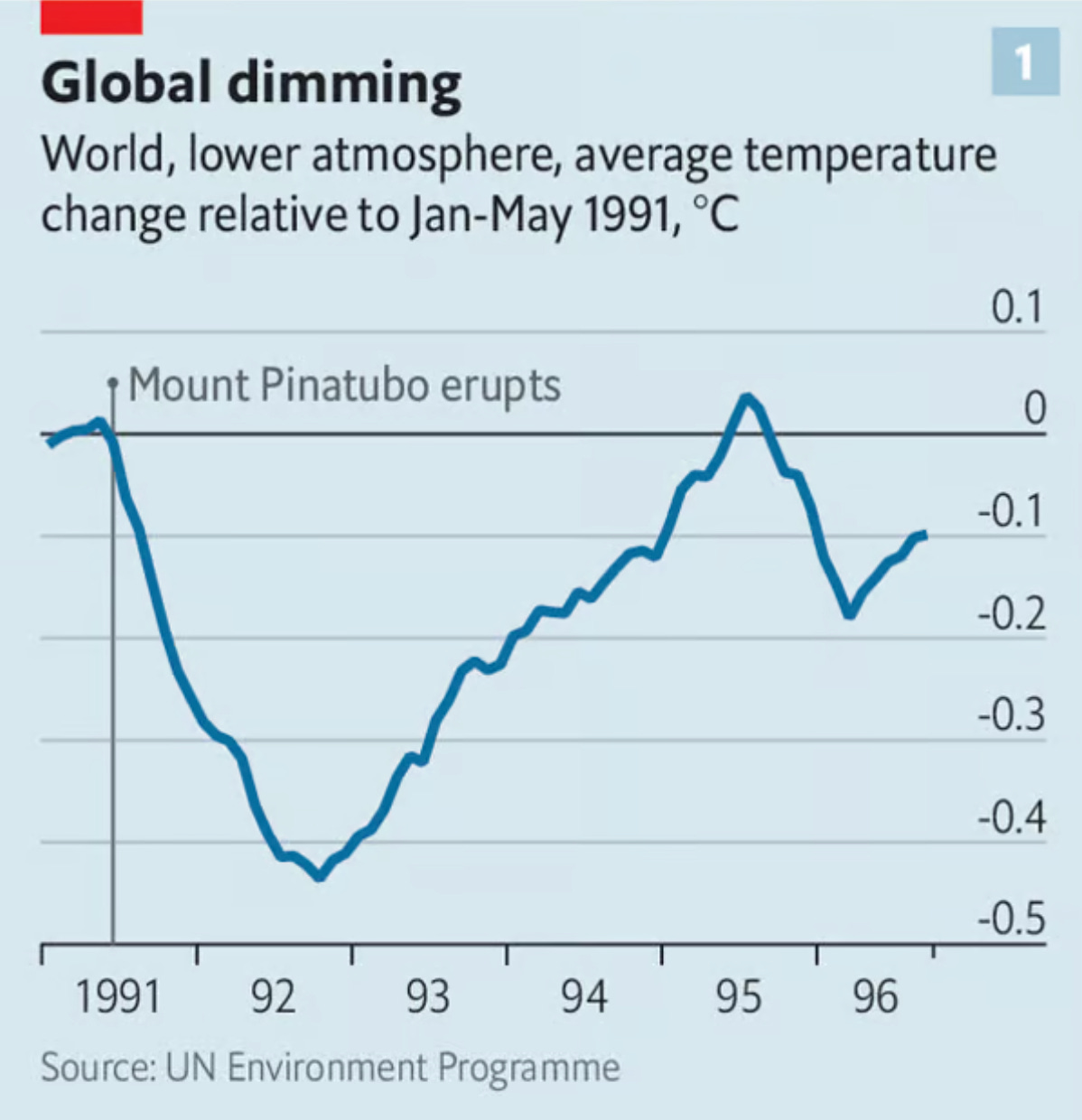
Today we’re emitting 50x more SO2 than we should need!
So yes, the SO2 we would need to add is puny.
You might be wondering: Wait, if we’re already releasing all this SO2, why do we need to add more?
Because that release is in the lower levels of the atmosphere—the troposphere. There, SO2 falls much faster, and is 25x less effective!
All these effects are quite well studied now. As far as I could tell, there is not much debate about any of this.
How Do We Release It?
With huge balloons!
The balloon would be filled with hydrogen and SO2 (at the bottom), it would float to the stratosphere and burn up there, releasing the SO2.
Why this way? Because it’s extremely cheap! It just requires the SO2 and the hydrogen to lift it and burn it in the stratosphere. More details in the premium article this week.
Where Should We Release the SO2?
Probably close to the equator, where heat makes air rise up to the stratosphere, from where it travels all around the Earth:
Scientists have modeled4 where to inject SO2 and have concluded that releasing it close to the equator, a bit north and south of it, would be ideal. It can be done with only a handful of injection points, and the SO2 settles out near the poles.
How High Should We Go?
It looks like ~20 km is the right altitude: The higher you go, the more time the particles spend in the stratosphere, but beyond 20 km, you don’t get a huge bonus by increasing altitude.5
How Fast Will It Work?
Pretty immediately. The moment the particles are up, they start reflecting the sunlight. Within six months, we would notice the temperature reversal.
What Are the Downsides?
You should already feel quite comfortable about this, since:
We only need to inject 2% of the SO2 we’re already releasing into the atmosphere.
It would be much higher up, which is safer than what we currently do.
Nature has been testing this for us for billions of years through its volcanoes.
Despite that, I still considered every downside, explained below. Here’s the summary:
We know a lot about the impacts of SO2 on different systems of the Earth. There are so many papers!
I couldn’t find any seriously bad effects.
However, I did find many positive effects! I didn’t expect that at all. Overall, I’m not sure that SO2 injection, well done, would be bad for the Earth even without the climate change benefits!
Acid Rain
We used to emit lots of H2SO4 (sulfuric acid), and we reduced emissions because they caused acid rain: Acid mixed with water, fell on land, and destroyed plants.
The problem with acid rain was not its existence, though, but its concentration. A little bit of acid isn’t problematic. A ton of it is. So the right question should be: At what levels is acid rain a problem, and would SO2 injection reach this concentration?
As you can imagine, it wouldn’t, since we would only be inserting an additional 2% of SO2 to the atmosphere, it would be spread across the entire world, and in the stratosphere instead of the closer troposphere. Indeed, scientists looked into this and concluded that the impact on ecosystems would be negligible.6
Atmospheric Pollution
SO2 injection would also lower temperatures. Yes, you’d imagine the lower temperatures is what we’re going for, but we’re looking for all potential downsides here. By lowering temperatures, we would also increase nitrate aerosols in the air, and that is bad for health, so we should count that.
Thankfully, SO2 pollutes 25x less in the stratosphere:
Each unit of [stratospheric] injected sulfur incurs 1/25th the particulate matter exposure of a unit of sulfur emitted from surface sources.—Quantifying the impact of sulfate geoengineering on mortality from air quality and UV-B exposure, Eastham et. al.
If we only inject an additional 2% of SO2 into the atmosphere, the impact is basically a pollution increase of particulates of 0.08%7—very little, and easily offset by our improvements brought about by electric vehicles, solar energy, and the like. And remember, that’s because of the “bad effect” of lowering temperatures!
Aside from particulates, SO2 would decrease ozone in the near atmosphere, and since ozone is a pollutant, that would be good.
However, a decrease in ozone would increase UV radiation, bad for skin cancers.
If you’re worried about ozone depletion, you should know that the person who first proposed SO2 injection was Paul Crutzen, a guy who won the Nobel Prize for figuring out the chemistry of ozone depletion, which led to the closure of the ozone hole. This is what he says in his paper:
Compensating for a CO2 doubling would lead to larger ozone loss but not as large as after Mount Pinatubo. Furthermore, the amounts of stratospheric chlorine radicals, coming from past production of the chloro-fluoro-carbon gases8, are now declining by international regulation, so that ozone will significantly recover by the middle of this century.
The Pinatubo eruption temporarily cooled the planet by about 0.5ºC, but the ozone layer did not collapse. More recently, an eminence in ozone depletion9, said that cooling the Earth by 0.5ºC with SO2 would have some effect on ozone, but it “will not destroy the ozone layer and create catastrophic consequences”.
Existing studies do not suggest a deepening of the ozone hole beyond that already experienced.10—Stratospheric Aerosol Injection and its Potential Effect on the Stratospheric Ozone Layer, Times, Haywood.
The balance of these three effects (ozone, nitrate particulates, and UV light) is a slight increase in deaths every year of ~40k people (equivalent to 1% more deaths from respiratory diseases) because SO2 would be lowering temperatures. However, this doesn’t include the broader effects of eliminating global warming: Millions of deaths, famines, wars, mass migrations… It just takes into account the direct impact of SO2 on nitrate aerosols.11 If you took out that downside, SO2 injection would reduce deaths from pollution, not increase them. You can see it here:

This paper doesn’t analyze the fact that by reducing climate change, there should be fewer dust storms and wildfires, two important sources of pollution that kill many people. If we combine these effects, it might well be that SO2 reduces overall deaths from pollution.
Less Light for Plants
Surprisingly, plants prefer less intense light than what they get from the Sun (more on that in this week’s premium article). SO2 might reduce direct light, but increase diffuse light, and the net might be positive. In any case, it wouldn’t reduce yields by much and other aspects of global warming and SO2 injection might matter more, like temperature and rain. For example, the CO2 increases in the atmosphere are improving agricultural yields by 30-40%.
Rains and Monsoon
It will probably rain a bit less with SO2. But since global warming increases rain, the net result should be that it still rains more than it used to. But not by much.
What would change is that we would get changes in where it rains more or less, depending on where we inject the SO2.
For example, a paper concluded that Indian monsoon rains might shrink by 7% if we release the SO2 close to the equator, but by 29% if we release it close to the poles.12
That said, it appears that the consensus is that a proper release strategy would mean fewer extreme rain events:
During the period of peak CO2 concentrations, stratospheric aerosols would reduce warming and lessen precipitation extremes (including droughts and deluges) for 99.6 percent of the planet's ice-free land surface.—Scientific American
In some regions, it will rain more than it used to, and vice-versa.
Two things surprised me while reading the literature on this. First, we’re still not sure how exactly SO2 injection would impact rains. Second, what we do know is that we will be able to dial where we change the rain, because rain patterns are very sensitive to where we inject the SO2. We could increase rain where we need it and reduce it where flood risk is too high.
This is overall much better than unmitigated global warming, and it might even be better than a world without either SO2 or global warming!
So as we scale this, we’ll need to learn from experience what is actually happening in the real world and adjust. If we just throw a bunch of SO2 in the air, we might end up with bad weather patterns. But if we measure the impact of SO2 and check that our models stand up to reality, instead of making the weather crazy as we are doing today, we could be stabilizing it.
More CO2 Absorbed
According to this review:
Injecting SO2 would help oceans absorb more CO2, which in turn would reduce CO2 in the atmosphere.
By cooling the ocean, it would increase the solubility of CO2, increasing its uptake by as much as 10%.
Lower temperatures would also improve carbon retention in the soil.13
Moral Hazard
I’ve been in contact with several SO2 experts, and all of them say the things I outline above are true. The disagreement is not on SO2 facts, but on human behavior. So do you know the main argument against SO2 injection?
What if it works? That would be bad!
I kid you not! This is the argument! Now, of course, they don’t say it like that. What they say is: If SO2 injection works well, it might reduce our urgency to fight CO2 emissions, which would be bad.
Aside from the narrow-mindedness of the argument, once you take a step back, even picking on the argument directly is easy.
There’s no turning back for renewables. Solar, wind, and batteries will take over most of the world’s electricity generation, and electricity will be replacing other energy vehicles throughout the economy. All of this simply because they’re cheaper than fossil fuels now. Decarbonization is now probably unstoppable. So a scenario where we get complacent releasing ever more amounts of CO2 is unlikely.
Even if this was not the case, plenty of people still want to decrease the CO2 we release. They would still be working on it. If they didn’t, that would be because they concluded there’s no need! Let them work on that, while others work on SO2.
What IF we do halt global warming AND we don’t decarbonize AND there are unintended consequences? In that case, we should look at them when they arrive, and deal with them. Did we deal with climate change in the 19th century? No, it’s a problem to tackle in the 20th and 21st century. As a rule of thumb, I have a philosophy: Let’s not solve problems we don’t have, and instead solve problems we do have.
The moral hazard argument is interesting in another way: It’s been used in the past and failed miserably.
For decades, environmentalists said “We shouldn’t talk about sequestering carbon! This will be an excuse to keep burning fossil fuels!” And they succeeded. For decades, it was a taboo. Did that make us curb our fossil fuel use? No, because most people say they care about the environment, but they’re not willing to dramatically change their lifestyles for it.
The result is that now it’s 2024, we’ve come to our senses, we’ve realized we can’t solve climate change without sequestering CO2, and we need to catch up on decades of delay on sequestration technology because we started late. Now the same kinds of people want to delay SO2 injection using the same argument! If we let them, the only thing that would achieve is to make the Earth burn a bit harder and delay the inescapable necessity of SO2 injection.
There is one way I’m sympathetic to this argument, from the eminent SO2 academic David Keith:
I expect that work on solar geoengineering, including my own work, will be actively exploited by those who oppose emissions cuts, most obviously fossil fuel companies and fossil-rich nations. Such groups will likely exaggerate the effectiveness of solar geoengineering and minimize its risks in order to weaken efforts to cut emissions
We absolutely need to continue cutting emissions and sequestering carbon. SO2 is not a complete solution. Getting CO2 levels back to normal is the end goal. This is a band-aid.
Termination Shock
A favorite argument for people who oppose SO2 injection is termination shock: What if SO2 is successful, but it has very bad unintended consequences, so we have to reduce the SO2 injected really fast? Then temperatures would go up really fast, and this temperature shock due to termination could be catastrophic!
This is very unlikely, and if it happens, probably not a big deal:
We’ve already modeled SO2 injection a lot.
It’s already released in bursts by volcanoes! And volcanoes then stop! So we know what it looks like to stop SO2 releases.
We would be inserting 2% more SO2 than we are already inserting. That’s nothing.
We’ve already tested a termination shock! Every time a volcano stops releasing its SO2. Or when we decided to reduce SO2 releases from shipping. The only problem that these termination shocks are producing is more global warming we should avoid.
“We Don’t Know Enough”
I can’t recall an academic saying “OK now we know enough, let’s just go all in!” They tend to prefer to learn more and study more before taking any action. I wonder why. Maybe they have an incentive to do studies? Maybe they’re self-selected to be people who prefer study to action?
Of course, they package it nicely. Like when they say “We should not be playing God with the elements.” Except we already are. That’s exactly what we’re doing with fossil fuels and mining and pollution and canals and ports and housing and roads and agriculture and every other thing that every human does. Why would we tie our hands behind our back with SO2 injection?
There are 30,000 results to the query SO2 injection on Google Scholar. Scientists have been chasing downsides of SO2 for decades and, as far as I can tell, have returned empty-handed of any big one. When will we know enough, when we have 100,000 papers?
You know why some scientists studying geoengineering are concerned? They’re skeptical because the models look too good!
I actually think models, in my opinion, make solar geoengineering look too good and too attractive.—Frank Keutsch, Stonington professor of engineering and atmospheric science, Harvard. Source.
The big question for Earth and atmospheric sciences is: How could we be wrong?
These models might be in some way biased to make solar geoengineering look too good. [...] Our generation are not the ones who’re gonna decide. [...] [Our work] provides the next generation with better information to make the right decision.—David Keith, Professor of engineering and professor of public policy, Harvard. Source.
What happens when you go the academic route? Harvard learned this the hard way, when it tried to get approval for an experiment releasing chalk rather than SO2 in the air. Three years ago. Just to fly the balloon without releasing anything! It got blocked.
Volcanoes have been injecting SO2 into the atmosphere for billions of years. We’re already inserting 50x more SO2 in the troposphere than what is needed in the stratosphere. We know SO2 falls from the atmosphere within two years, limiting its impact.14 When will we know enough?
Luckily, academics are changing their minds, and now they’re more open than ever to the idea of SO2 injection. Some even agree:
We’ve learned quite a lot from modeling research, but we’re starting to get diminishing returns. If we’re going to progress this we need to do some [real world] experiments, albeit in a responsible way.—Rob Bellamy, climate and society lecturer at Manchester University. Source.
In 2023, 110 climate scientists published an open letter urging government support for solar radiation modification (SRM) research. The following day, the United Nations called for international regulations that could pave the way for experimentation.
What do the most famous SO2 experts suggest as the next step in research? We would need to inject several hundred thousand tons of SO2 every year to reverse 10% of the warming. The minimum viable experiment, in other words, “would be indistinguishable from a deployment”.
What Does the World Think?
The debate is changing.
Since the start of 2023, solar geoengineering has been the whole or partial focus of reports published by the European Commission and Parliament, America’s government, the Climate Overshoot Commission, and four separate bits of the UN.15—The Economist
The Biden administration’s report outlined what a research program could look like. Here’s one quote from it:
Outdoor experiments would be valuable in combination with model and laboratory studies for understanding the processes involved with potential SRM deployment. Outdoor experiments would benefit from development and testing of aerosol injection technologies, observing systems, and analysis tools.
Many countries are not sure how to react, swindled by the type of environmentalist who also wants nuclear power plants banned, who fantasizes about a world that reverses the clock ten thousand years. The result is that they’re cautious, asking for more research, like Switzerland did a few days ago to the UN.
But this sounds like a luxury belief to me—it makes you look good at the expense of poor people. More research? Who can complain about that? Research is always good! Except when it delays action. And many countries need action. Now.

So yes, let’s keep studying. By getting real data. The more serious researchers in the field are calling for tests injecting tons of SO2 into the atmosphere. Let’s help them do that. And if we can delay global warming in the process, we must do it. The Earth is burning. It’s time to stop it.
The Make Sunsets Approach
That’s what Make Sunsets is doing. Tired of waiting around, they just decided to make it happen. They get balloons, fill them with SO2, and release them.

The concept is pretty simple: Fill a balloon with helium, add the SO2, attach a box to measure everything and a parachute, and just let it float to the stratosphere where it will burst and release the gas.16 Do that 1,000 times, increase the balloon size and decrease the launch costs each time, and voilà.
After my previous article in which I mentioned them, the founders Andrew Song and Luke Iseman reached out to me to see if we could collaborate. I asked them a million questions to write this article.
Do You Deliver What You Promise?
The balloons are designed to pop above 20 km. The box attached to the balloon17 measures the altitude reached before it bursts. They only count the cooling credits when they reach an altitude of 20 km or higher. On occasion, they’ve reached 50 km!!
When they scale up, they will have a dedicated chamber to release the SO2 and the balloons will be reusable. They’ve been deploying 1 kg of SO2 at a time as of late, which offsets the warming of 1,000 tons of CO2 for a year.
Today, they launch the balloons from the US, with approvals from the National Oceanic and Atmospheric Administration and Federal Aviation Administration.
Is This Legal Then?
Countries control the seas up to 22 km from the coast. Beyond that, it’s international waters and anybody can release what they want. In other words: Somebody who wants to inject SO2 into the stratosphere can simply sail 22 km off a coast and release it there.
Most countries want to leave the sea and airspace between countries international because otherwise they couldn’t fly their airplanes—and missiles—around freely. So jurisdiction is unlikely to change.
An organization injecting SO2 into the stratosphere would have two options:
Launch from international waters. No government approval.
Launch from land. Governmental approval required.
Here’s some good news: There are no international agreements banning the release of gases like SO2! Naturally, since many countries release a lot of it! Which means that any country can decide to approve or ban these releases within their borders, but none can say anything about what is released outside their borders.
In other words: You can either get one single country to approve your releases, or you can just sail away to do it.
Is this likely to change? Is an international agreement coming to ban the release of gases into the atmosphere? Unlikely, since we’re already doing a lot of it:

If you want, in the US, you can simply file a weather modification report to National Oceanic and Atmospheric Administration (NOAA). Dozens of organizations are doing this routinely:
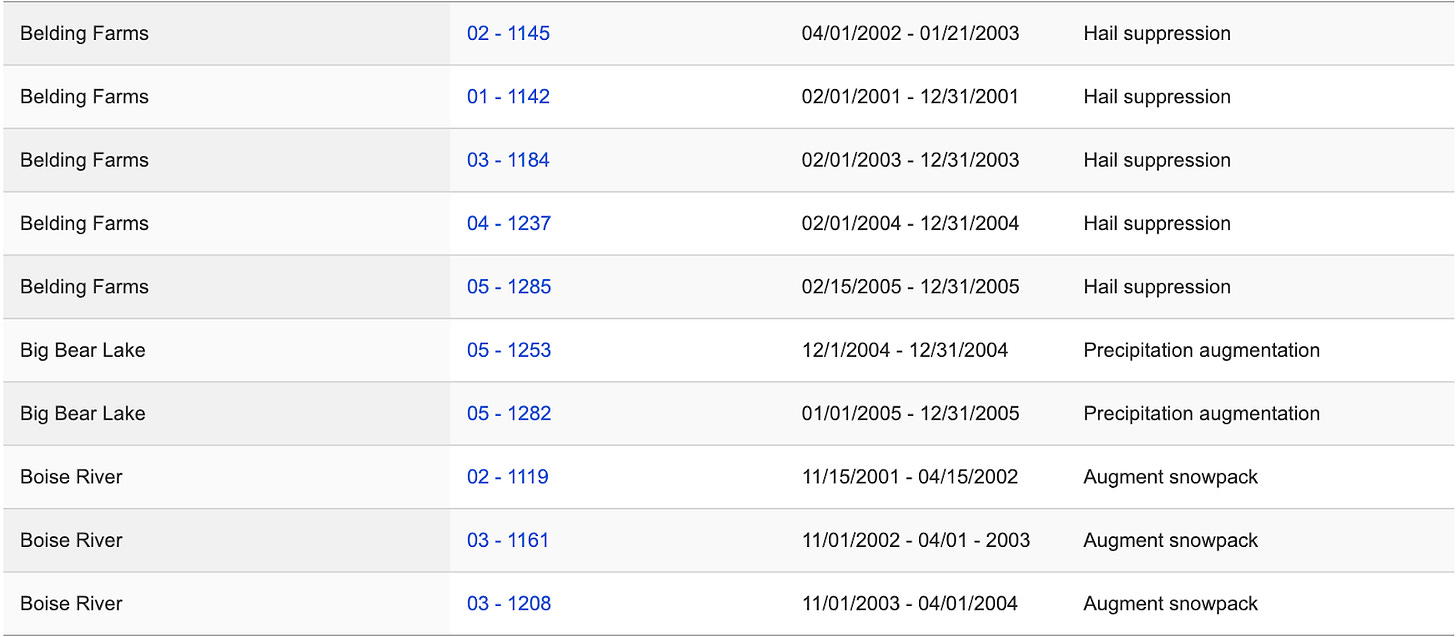
Is there any other legislation that we should worry about? Even opponents don’t think so:
In all likelihood, they are not breaking any current law or regulation.
Launching weather balloons is a very lightly regulated activity, pursued by hobbyists and citizen scientists in many countries. In the United States, you don’t even need a permit for individual launches, so long as you keep the payloads small (the few Kg for which weather balloons are designed), don’t fly an operating cellphone, don’t drop anything without a reliable parachute, and stay away from busy or controlled airspace. (Relevant FAA regulations here18, FCC regulations here, with a clear summary from a citizen-science NGO here).
The tiny quantities released from each balloon would also escape existing environmental controls, either by falling below de minimus numerical thresholds or by not falling within specific identified categories of regulated activity. Multiple domestic laws and international treaties are “relevant” to the activity, but it does not fall under their specific concrete controls. If the aggregate scale of the activity expanded a lot or came to involve significant government participation, it would very likely fall under environmental impact assessment requirements. But at present, and under any reasonably likely expansion, it appears not to be violating any law.
So this is legal.
How Much Does It Cost?
The Make Sunsets team was pretty open with me about their costs. Today, it costs them 28 cents per gram of SO2 (and therefore per ton of CO2).19
It costs Make Sunsets $0.28 to offset one ton of CO2 (ie, per gram of SO2) for two years, and they charge $10 for it, because today most of the cost is not the balloons; it’s the cost of the small team that is figuring out how to make this work.
How Does That Compare with Current CO2 Sequestration Costs?
We need to sequester CO2 eventually, but it will take us a very long time because today the cost is exorbitant.
As of February 2024, it was $140 per ton of CO2.
A new Department of Energy report argues that by 2050, the United States might be able to suck 1 billion tons of carbon dioxide out of the atmosphere for a mere $130 billion a year. That’s $130/ton… in 17 years.
The price depends a lot on the approach:
Many of these offsets are fake. Of the legitimate ones, the cheapest approach, microalgae, is 5x more expensive than what Make Sunsets charges, and nearly 200x more expensive than what it costs them—which is where prices will converge with volume! Of course, this is not the same because sequestering CO2 eliminates it from the atmosphere and SO2 offsets the warming for 1-2 years, but the price difference of SO2 injection is still flabbergasting—and it’s going to get 1000x cheaper.
How Can We Reduce Costs Over Time?
The main costs of these balloons are the balloon, the sulfur, and the gas to lift them. But we can make the balloon huge, move from SO2 to sulfur, and move from helium to hydrogen, which would drop the cost to 27 cents per kilogram rather than today’s $28 per gram. Details in the premium article this week.
But to drop the cost like that, the Make Sunsets team needs lots of volume.
This is where you come in.
How Can YOU Help SO2 Injection?
The more we believe SO2 injection is right, the more we can tell everybody about it and normalize it, the more it will be OK to study it in the wild.
Also, the more we help Make Sunsets by buying their cooling credits, the more they can shrink their prices, the more customers they will have, the more they will be able to reduce their prices further, in a virtuous cycle that can put the brakes on global warming.
The more volume they inject, the more they will attract attention and normalize it.
So I asked them: Could we have a bulk discount for Uncharted Territories readers? And they said yes: They’re willing to give us a 90% discount if we spend at least $1,000.
For every $1 that you spend, you offset the warming of 1 ton of CO2 for two years.
(You need to add to cart before seeing the discount). If you prefer to subscribe for a recurring subscription instead:
How Much Should You Offset?
The average person in the world emits 4.5 tons of CO2 per year.20 An average 30 year old will have emitted 135 tons of CO2 over their lifetime, and it would cost them $135/year to offset all their warming (plus $4.5 per year, since they keep adding CO2).
Of course, emissions differ by country and age:
Rich countries are reducing their CO2 emissions per capita, while poor ones are increasing it.
So it will cost more to a 70 year old Canadian to offset his CO2 than a Brazilian.
The other big determinant of your CO2 emissions is your income.

So if you’re a US person making $150k a year and you’re 40 years old, you have probably emitted around 2,700 tons of CO2 so far. Since in developed economies, CO2 per capita drops by approximately 2% every year, you will emit an additional 1,600 tons in your lifetime. You could offset all the global warming you will ever cause by paying Make Sunsets $2,700 per year, and adding $70 more every year.21
I put together a small Google Spreadsheet so you can play with the data. Copy and paste to your own:
As a comparison, if you want to sequester that CO2, assuming the cost is going to be $100/ton, that would be about $400k.
But even offsetting your CO2 through this means can become expensive quite fast for many people. And I don’t think that’s the point. The point, instead, is to offset some of our CO2 to support Make Sunsets, so they can grow bigger, shrink their costs, make it more affordable for more people to offset their CO2, and lead the world. If you can only afford $100/year, that might be enough to jump-start this process. That’s what I’m going to do.
Conclusion: Should We Do This?
Yes:
So why haven’t we done it yet? Because the conversation was stuck in the academic world, where out of excessive precaution, some academics wanted to study this more.
It’s time to do it: Study it at scale, in the real world.
When they tried, they were stopped by environmentalists who live in fantasyland: They don’t want to accept that we live in a capitalist world where people care more about their comfort than the environment and aren’t willing to change their behaviors to stop climate change. Politicians and journalists picked up on that, and started virtue-signaling their luxury beliefs, making it look like the deluded option was the righteous one.
I wish we could stop emissions and capture carbon in time. We can’t. But we can delay their effect until we’re there.
It took a couple of renegades to say: Haters gonna hate. It is obviously the right solution. If nobody’s going to do it, we will.
We should help these renegades who’re doing the right thing against the righteous and confused obstructionists. The more of us who do that, the more we will be supporting them, the more we will delay global warming, and the more we’re going to signal to the world: This time, we’re going to do the right thing.22
If you know a politician from a small island close to the equator, send them this article and tell them to get in touch with Make Sunsets (I can intro you). They’re ready to launch from your country.
What we’ll cover later this week in the premium article this week:
How does SO2 reduce temperatures?
Didn’t cargo ships just stop emitting it? What happened?
How would SO2 affect rains in different parts of the world?
What do the balloons look like today? What will they look like eventually?
How to reduce their cost by 1000x?
Why are plants green? Why do they reject some sunlight?
Who owns the stratosphere?
What are the alternatives to SO2?
What does all this tell us about how we learn?
Thank you Andrew Song, Luke Iseman, Casey Handmer, Nephew Jonathan, Heidi Hughes, Shoni Buell, David Keith, and Ben James for your edits and ideas (which don’t mean endorsement)!
My philosophy is to put my money where my mouth is. When I support something, it’s because I believe in it and want to see it succeed, so I’ll put all the resources behind it that I can. If I make money from this, great, but I don’t expect to, as I explain here. Rather, I do it because it aligns my words with my actions.
And possibly methane
David Keith and his research team at Harvard are behind a lot of the research in this space. I took this number from Keith’s team. The Make Sunsets team had their own estimation and reached a similar conclusion (math spreadsheet here, explanations in the link just before). I eyeballed the calculations but didn’t thoroughly verify them.
There are actually dozens of papers on this! I didn’t read them all but you can get a glance from the intro of this paper.
And knowing 20 km is what we’re aiming for would narrow down the injection sites we need. I found a paper that looked into different altitudes and found that 20.5 km was great, but can’t find again. Here’s another paper that discusses altitude.
And they were modeling with 50% to 150% more SO2 injection than would be necessary.
2%/25
These are the gases that dramatically destroyed the ozone layer and caused the hole.
Dr. Fahey, the director of the National Oceanic and Atmospheric Administration’s Chemical Sciences Laboratory and a co-chairman of the Montreal Protocol’s scientific assessment panel. The Montreal Protocol was the one meant to address the hole in the ozone layer.
But also, “current shortcomings in model representation of required processes limit confidence in the results.”
All from this paper.
We said we wanted to release it close to the equator anyway.
This is an upside, not a downside, but since my studies of downsides showed many upsides, and this is when I found this, it fits.
When it would fall, it would be mainly as rain/ice/snow in the poles. In doing so, it adds like very tiny amount of sulfur, less than the width of a snowflake.
Most of them are in favor of more research, but hesitate to endorse full-blown SO2 injection schemes. They want to appear cautious, because it’s easier to do that than to take a bold stance. Nobody will ever criticize them for “more research”. Or so they think. We should change their mind.
More specifically, they first weigh the empty balloon, fill the balloon with helium, add the SO2 to the balloon and weigh it again, fill with helium. Once it has the right amount, attach the parachute and telemetry box to measure everything.
From Andrew Song, founder of Make Sunsets: Instrumentation differs since we test all the time. But tracking altitude, latitude, longitude, temperature, camera, Apple AirTag, are some of the components we use.
Planes fly in the dense troposphere, not the thin stratosphere, so the Federal Aviation Administration (FAA) doesn’t care much as long as you don’t release the balloons on flight paths and you don’t tether them. Tethering was the main issue in initiatives like Google’s Loon, which wanted to provide Internet across the world from their balloons. Pilots don’t appear concerned about this. It’s very hard to hit a balloon, and if you do hit it, it’s like a small bird.
A balloon costs them about $450 and lifts about 1.6 kg of SO2.
Let’s assume we should only offset CO2 and not other greenhouse gases. Methane is about 17% of total emissions. CO2 really accounts for 75% of global warming, so a good rule of thumb if you want to account for all your warming contribution is to add 33% to whatever CO2 you think you need to offset.
I thought hard about what would be the right way to align myself with Make Sunsets. Taking a share of their revenue from this, or money for this article as an ad, sounded like a misalignment of incentives, as I might be selling false information to increase sales. Instead, I want to put my money where my mouth is. This means offsetting my own CO2, but also investing in Make Sunsets. I don’t think I will make money from this, because if it truly works, they will have little defensibility: Any other company can start launching balloons. But if it works, I might, and I’d be happy if it’s the case. This aligns much better than a straight share of revenue from referrals, because that commission would be independent of the company’s long-term result. If they fail, or the world decides this is the wrong solution, then I won’t make money. I would only make some money back if we’re helping the world decide that this is the right solution—if it sees it, and if Make Sunsets executes well.






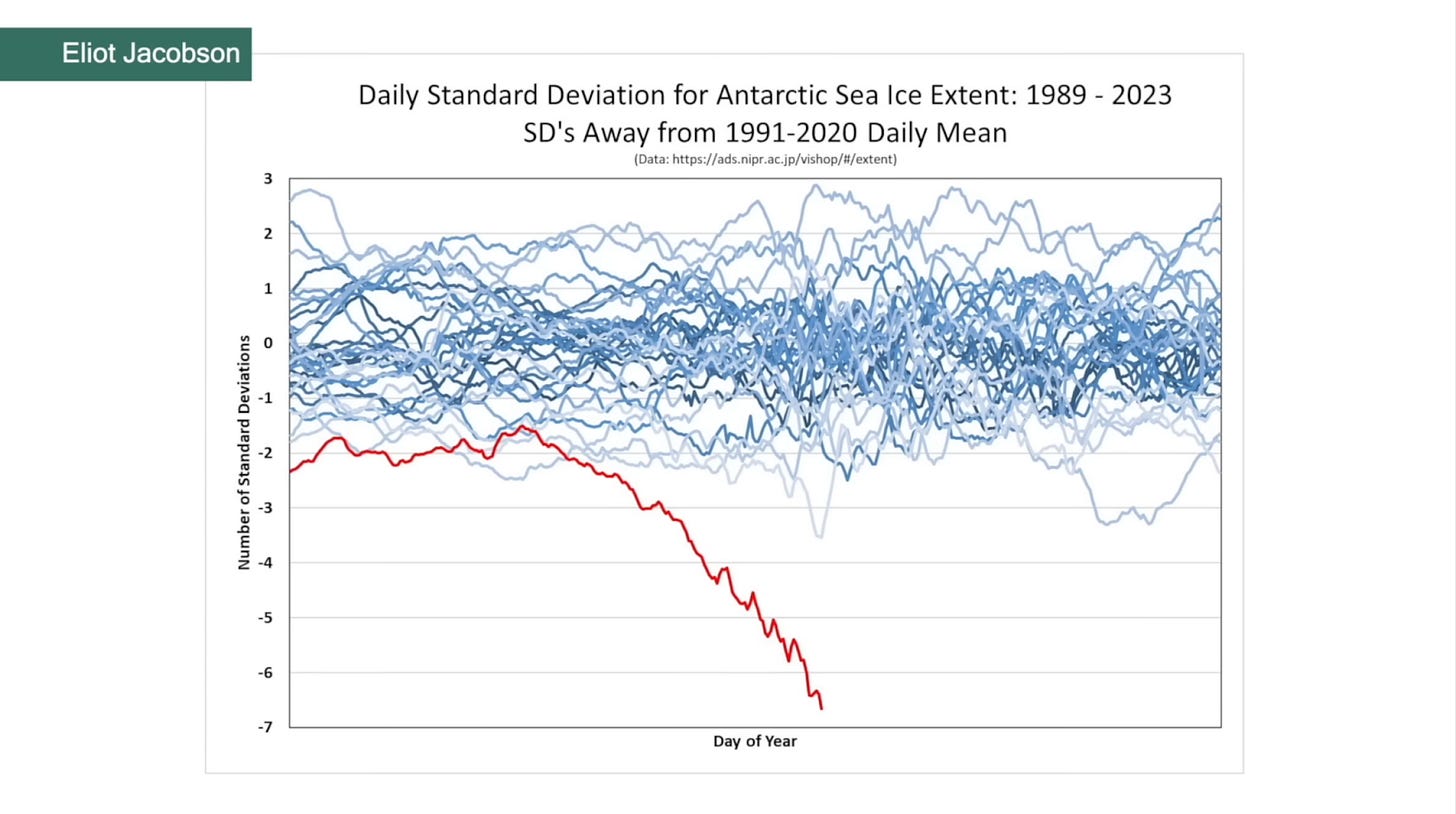




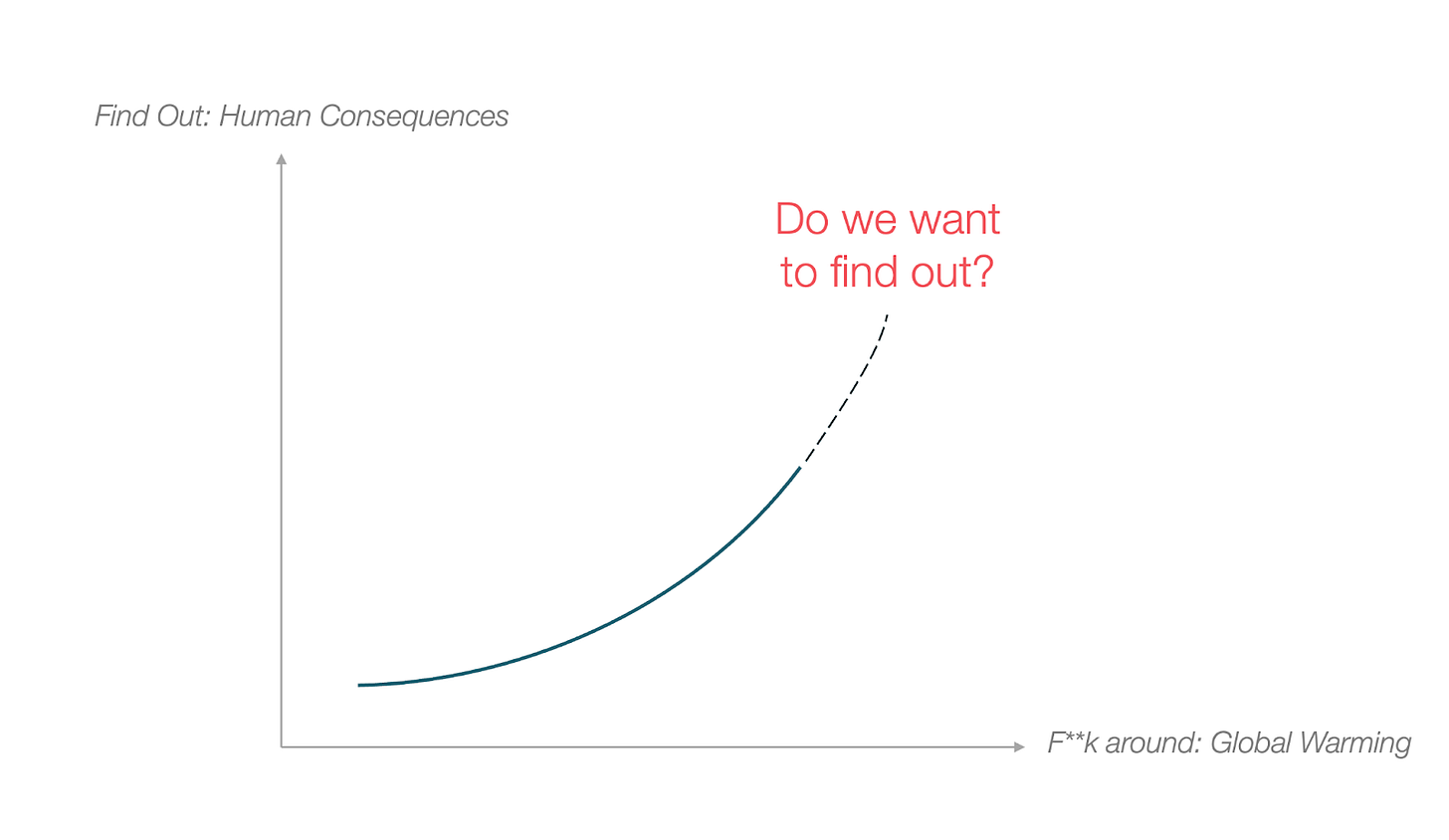
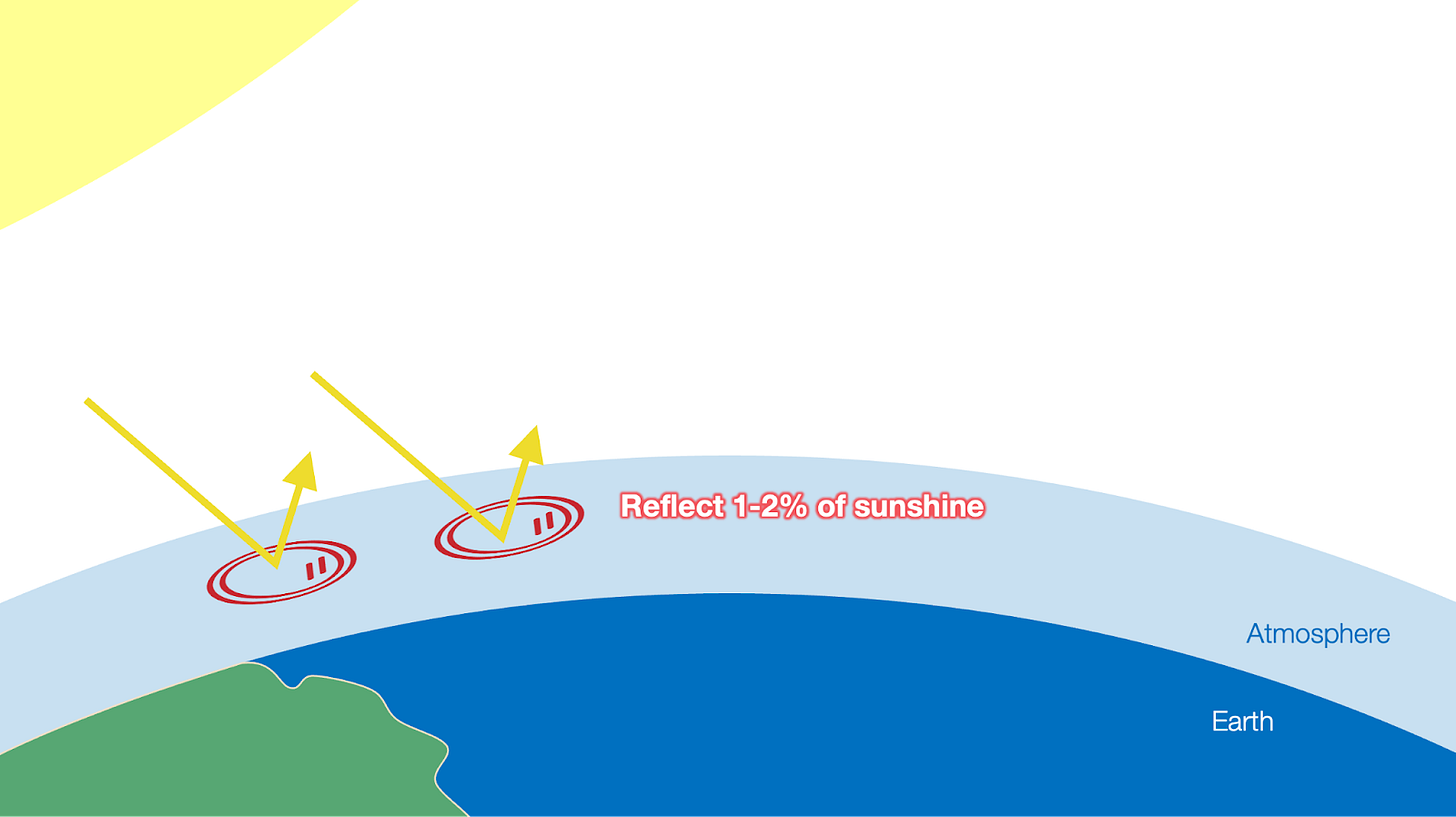

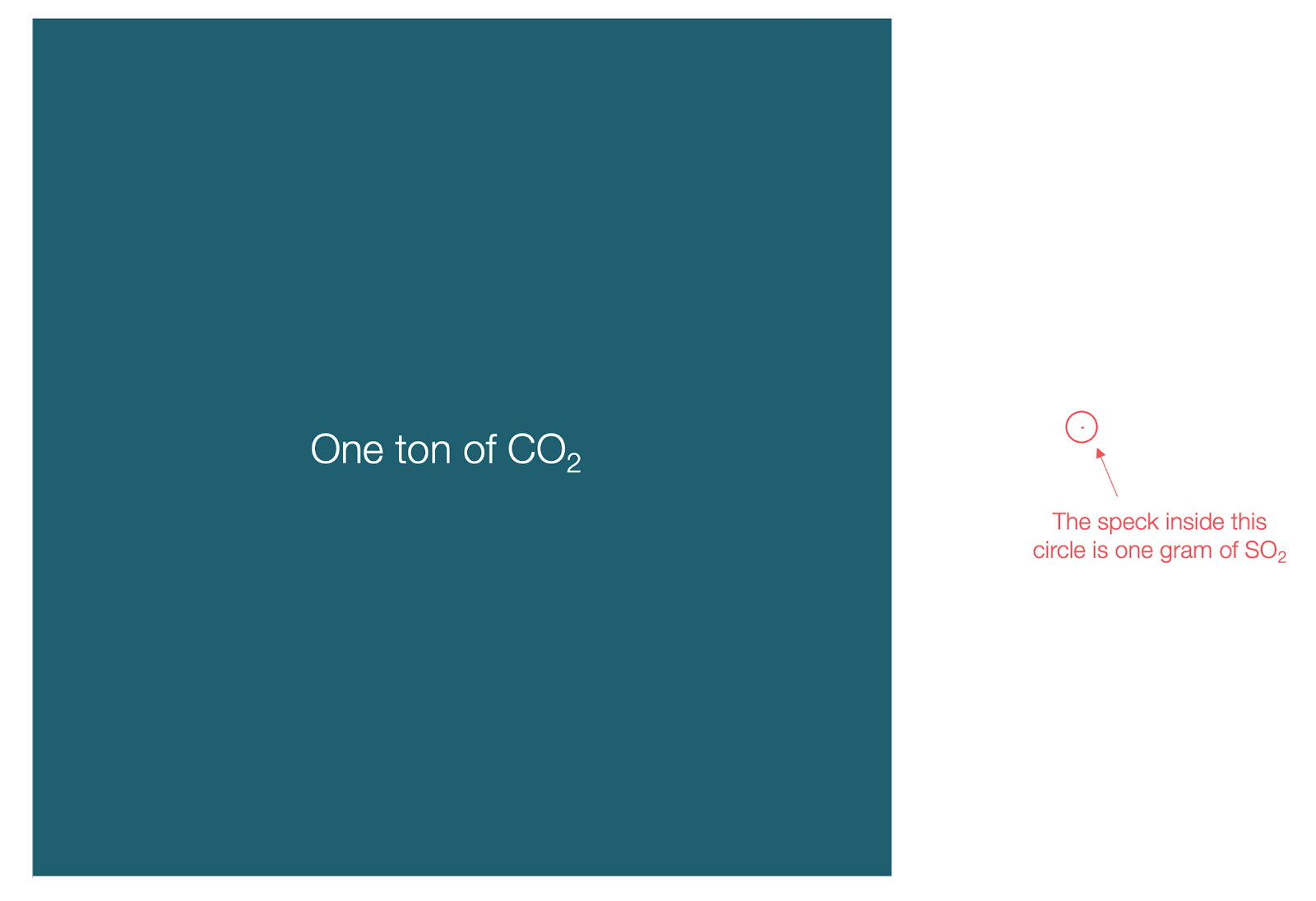




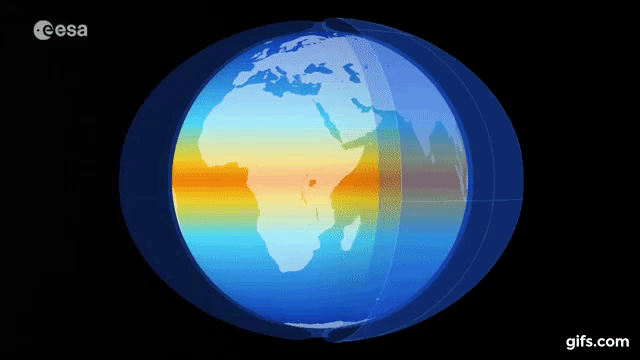






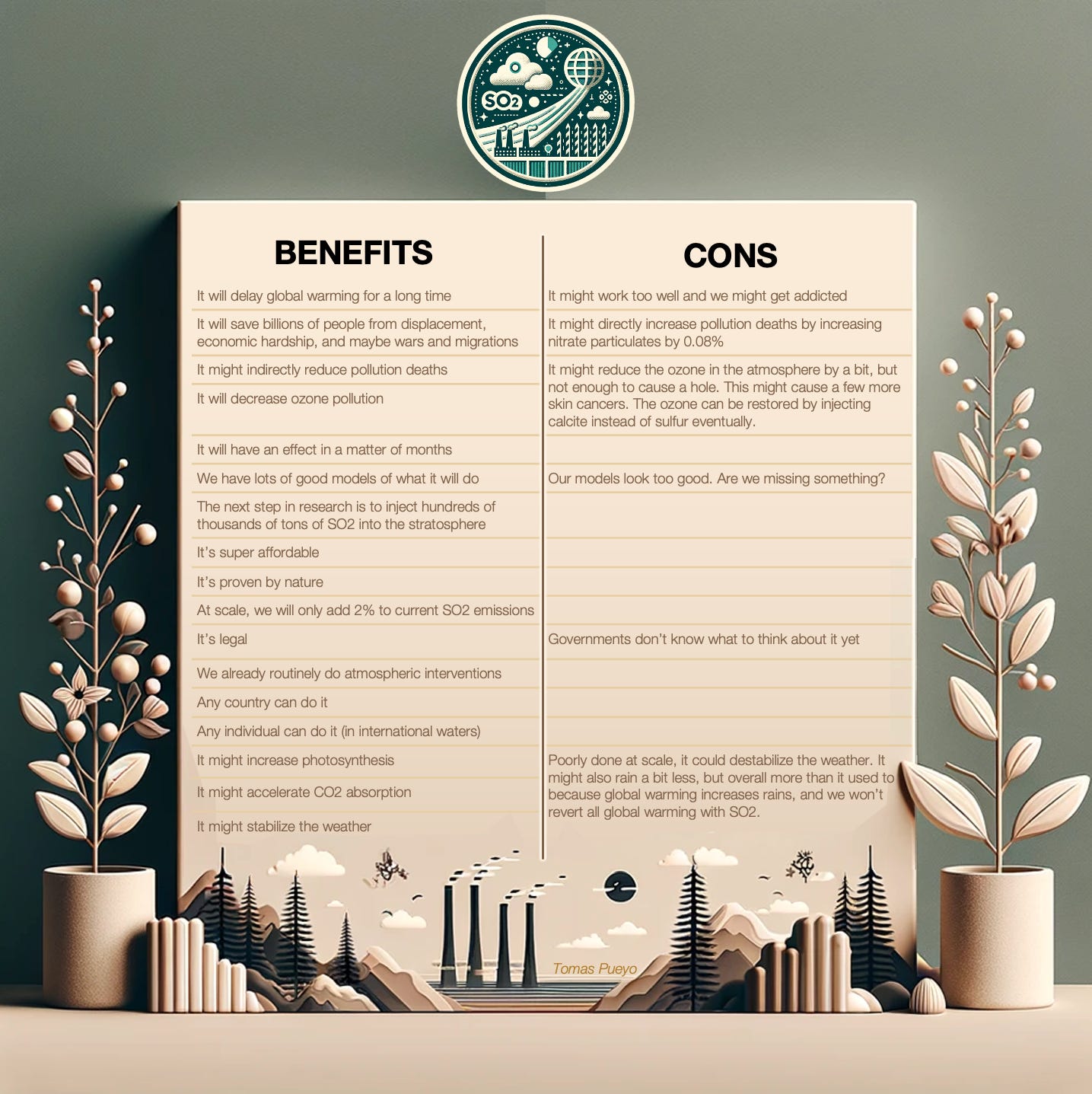
Sorry for suggesting a bit cynical approach, but this is just how our societies work.
If this is called "geoengineering" then it will provoke massive protests and legislators will implement paralysis through analysis.
Instead, we should implement this as a minor side effect of an economical activity. Let's say that we would have "stratosphere tourism (for the rich) that emits just a fraction of a percent of SO2 compared to shipping". That would be such a minor issue that nobody would care.
I mean burning fossil fuels, space tourism, flying by plane, emitting gigantic amounts of SO2 by ships, modern massive agriculture etc are all massive acts of geoengineering but as they have not been positioned as such then no-one cares about the geoengineering consecuences.
One thing I would suggest is a PR campaign (your article is a great start!) to explain this to the developed countries population (especially United States). Get ahead of all the naysayers & people who are profiting from the current approaches. Maybe get 60 Minutes to do a story, or even better Fox News!
Stress that this is a temporary measure to help us transition to a lower CO2 world, and that we can scale it up in a measured way to make sure there are no unforeseen impacts.
Love the article.